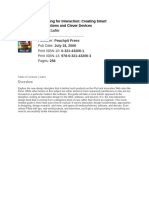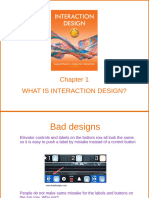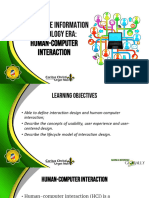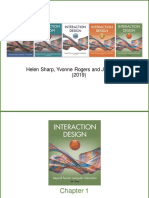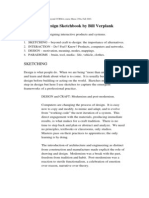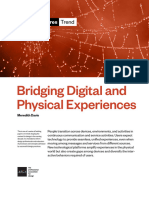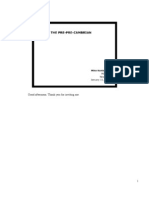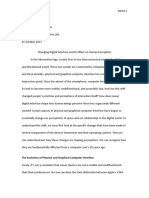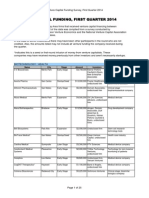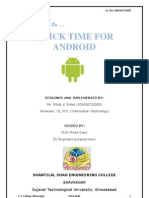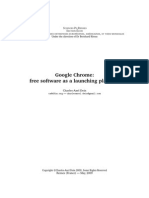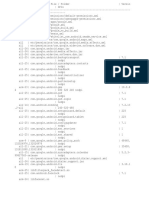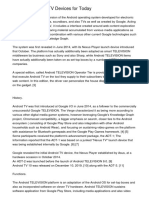Why a New Golden Age for UI Design Is Around the Corner | Wired Design | Wired.
com
http://www.wired.com/design/2013/08/design-and-the-digital-world/
Designers are working on their most ambitious challenge yet: weaving the digital world into our everyday lives so seamlessly that we dont even notice. Design
Creating What's Next
Design BY CLIFF KUANG 08.13.13 6:30 AM Share on Facebook shares
Why a New Golden Age for UI Design Is Around the Corner
ver the past four years, the Walt Disney Company has been engaged in a secretive effort to redesign the Disney World experience. Itll go like this: You buy your ticket online and plan all the details of your visit. Then youll get a wristband in the mail, which will be a passport to the experience that youve curated. Snug around your wrist, the so-called MagicBand will use radio frequency to communicate with sensors around the park, all orchestrated by software that effectively turns Disney World into a
computer interface. You can enter the park by holding your hand up to a kiosk; you can arrive at shows with 30 seconds to spare, having already reserved your seats; you can jump onto rides youve selected at preselected times without waiting in long lines; you can buy anything you want with a wave. An Its a Small World character could call you by name and wish you happy birthday. So could Mickey, who can also greet you at a preselected meeting time. This is all in the service of fun, of course, but it is also a glimpse of the future: an integrated experience, a smooth hybrid of real-world and digital interactions. This represents a new frontier for design. Over the past 30 years, as every facet of our lives, from our shopping to our schooling, has migrated onto computer screens, designers have focused on perfecting user interfacesplacing a button in just the right place for a camera trigger or collapsing the entire payment process into a series of swipes and taps. But in the coming era of ubiquitous sensors and miniaturized mobile computing, our digital interactions wont take place simply on screens. As the new Disney World suggests, they will happen all around us, constantly, as we go about our day. Designers will be creating not products or interfaces but experiences, a million invisible transactions.
Andrew B. Myers
1 of 7
08/22/2013 04:49 PM
�Why a New Golden Age for UI Design Is Around the Corner | Wired Design | Wired.com
http://www.wired.com/design/2013/08/design-and-the-digital-world/
WE ARE CONSTANTLY ADDING NEW GADGETS. EVEN AS THEY HAVE GOTTEN SIMPLER INDIVIDUALLY, THE CUMULATIVE COMPLEXITY OF ALL OF THEM TOGETHER IS INCREASING.
Already were seeing a groundswell of new products that insinuate themselves seamlessly into users lives. These include personal sensors like Jawbones Up, the voice- and gesture-controlled Xbox One, hyper-intelligent apps like Highlight that alert you to interesting people in your immediate vicinity, and Automatic, a gadget that communicates with your smartphone to tell you when you are driving inefficiently. But this is just the beginning. Within the next five years we will be surrounded by embedded devices and services. Just as the rise of the screen challenged designers to create software interfaces, the rise of screenless digital interactions will challenge them anew. After all, its one thing to invent a unique kind of digital experience in Disney World, a controlled space where people expect magic. Its altogether trickier to do the same thing in peoples houses, offices, and bedroomsthe most intimate areas of their livesin a way that feels both natural and inevitable. Bill Buxton bears a striking resemblance to Doc Brown from Back to the Futuremore strapping than youd expect for a mad scientist, his bald head rimmed with a snowy hedge of hair. In conversation, he can be piercingly intense. And just like Doc Brown, in 1985 he unleashed a breakthrough. Buxton, a lifelong musician who has also worked for Xerox PARC and Silicon Graphics, created one of the worlds first multitouch interfaces when he turned an electronic drumhead into a tactile synthesizer control. That drum was a progenitor of every touchscreen in use today. In the mid-aughts, Buxton wrote a journal article that helped define a new discipline called experience designa focus not on products or devices themselves but on the impact they have on peoples lives.As an example, he wrote about two orange juice pressesan electric model and a manual lever press called the OrangeX. The electric juicer had flimsy plastic buttons, and the motor screeched to life with an annoying whir. The OrangeX required a bit more effort but also sported an inverted rocker crank that gradually transmitted more force as you pressed down. Buxtons point was that the OrangeX created a feeling of tangible mastery that helped him enjoy the juice more. Designers didnt shape just gadgets but behaviors and visceral responses around those gadgets.
2 of 7
08/22/2013 04:49 PM
�Why a New Golden Age for UI Design Is Around the Corner | Wired Design | Wired.com
http://www.wired.com/design/2013/08/design-and-the-digital-world/
Microsoft Researchs Bill Buxton, holding the GRiDPad 1910, an early tablet computer.
Eric Ray Davidson
3 of 7
08/22/2013 04:49 PM
�Why a New Golden Age for UI Design Is Around the Corner | Wired Design | Wired.com
http://www.wired.com/design/2013/08/design-and-the-digital-world/
Matt Webb, CEO of London design firm Berg, is inventing a system that will allow multiple users to share smart connected devices.
Levon Biss
Today, Buxton, who is principal researcher at Microsoft Research, says that the next challenge for experience design is to create a constellation of devices, including wearable gadgets, tablets, phones, and smart appliances, that can coordinate with one another and adapt to users changing needs. This focus on the totality of our devices stands in contrast to where we find ourselves today: constantly adding new gadgets and functions without much thought as to how they fit together. (For instance, anyone lugging around a laptop, iPad, and iPhone is also carrying the equivalent of three video cameras, three email devices, three media players, and probably three different photo albums.) Even as our devices have individually gotten simpler, the cumulative complexity of all of them is increasing. Buxton has said that the solution is to stop focusing on the individual objects as islands. He has come up with a simple standard for whether a gadget should even exist: Each new device should reduce the complexity of the system and increase the value of everything else in the ecosystem. To see what he means by increasing the value of the ecosystem, consider the phone syncing built into many cars. After you link your phone, the vehicle boots up its own voice-recognition technology so you can make hands-free calls. When you leave the car, you simply grab your phone and it blinks to life again. The car and the phone engage in a quiet dialog geared toward providing only the capabilities you actually need at any moment.
4 of 7
08/22/2013 04:49 PM
�Why a New Golden Age for UI Design Is Around the Corner | Wired Design | Wired.com
http://www.wired.com/design/2013/08/design-and-the-digital-world/
WITHOUT THE PROPER DESIGN, ANY NEW TECHNOLOGY CAN BE TERRIFYING. THE TASK OF MAKING IT CANT BE LEFT TO ENGINEERS ALONE.
If all our devices interacted so cooperatively, whole new possibilities would begin to emerge. For example, Frog, the company best known for the Apple IIcs industrial design of the early 1980s, has been building a prototype lightbulb that will sense where people are in a room and project touchscreens onto walls or tables. Now imagine if a device like that could communicate with your mobile gadgetsif the lightbulb, sensing your presence in the kitchen and knowing the apps on your phone, projected your cooking apps onto the refrigerator when you began preparing dinner. To deal with such complexity, our devices will have to become smarter. Dave Morin, CEO of mobile social-networking company Path, has a maxim to explain how to think about the coming age of experience design: AI is the new UI. That is, the effort and attention that designers once poured into interfaces should be extended to code that doesnt just react to the push of a button but anticipates your actions. For instance, Path will automatically update your location when it senses that youve settled somewhere new. But thats really just a proof of concept. Morins maxim hints at the silent conversations that our phones and wearable devices will have with the world around us and each other. For example, Apples new mobile operating system, which uses Bluetooth Smart to share data with devices in your vicinity, could power a number of these kinds of intelligent background features.
5 of 7
08/22/2013 04:49 PM
�Why a New Golden Age for UI Design Is Around the Corner | Wired Design | Wired.com
http://www.wired.com/design/2013/08/design-and-the-digital-world/
Innovations like this present great challenges for designers. Todays app and software designers already have a deep understanding of how customers interact with their products. They know down to the pixel where to place a button, how fast a screen should scroll, and how to make an app simple without making it simplistic. But as designers move off of screens and into the larger world, theyll need to consider every nuance of our everyday activity and understand human behavior every bit as well as novelists or filmmakers. (Otherwise they may engender the same kind of backlash as Google Glass, a potentially cool product that has unleashed a torrent of privacy concerns.) That will require a shift in how tech designers view the world. Matt Webb, CEO of Berg, a London design firm that has created forward-looking prototypes for clients such as the BBC, Google, and Nokia, says it will demand thinking beyond todays standard scenario of a person working on a computer. For example, he says, our technology cant understand what it means to be in a room of two to six people. I find it totally nuts that when you sign in to something, no one else can use it. Imagine having to sign in to a lightbulb before turning it on! Berg is trying to solve that problem by inventing a system that will allow multiple users to share smart, connected devices that can adjust to their individual tastes and preferences. Thats the world we actually live in, says Jack Schulze, Bergs cofounder. But its a massive challenge for software. Just consider how these challenges apply to Netflix: If your spouse watches something on your account, it probably renders the companys super-sophisticated recommendation engine worthless. Netflix is trying to address this problem by creating a feature allowing multiple user profiles on one account. But even thats the wrong solution, Webb says. When we watch TV together, that group isnt just multiple people added together. That group is something more. Its easy to imagine a smarter, future version of Netflixone that uses, say, an Xbox Kinect camera to recognize whos in the room and can determine everyones overlapping interests. The true potential of experience design comes as that kind of sophistication gets applied to all of our interactions. We have all of these incredible benefits to our online life, says Jake Barton, founder of Local Projects, a media design firm, and theyre suddenly being applied to physical space. Take the example of Warby Parker, the online eyewear retailer that has begun opening retail storefronts. Imagine if the store automatically brought up your online profilewhich youve already filled with your favorite stylesallowing you to focus only on the glasses that the companys computers know you already like. Or look at Nespresso, whose physical stores offer its customers an RFID card that allows automatic billing and personalized service based on purchase history. Barton believes that the next step will be to create a universal, portable electronic identity that allows all of our experiences to be that customized. Companies like digital-payment pioneer Square are already working to build just that. In the wrong hands, this is a dystopian prospecttechnologys unwanted intrusion into our every waking moment. But without the proper design, without considering how new products and services fit into peoples day-to-day lives, any new technology can be terrifying. Thats where the challenge comes in. The task of making this new world cant be left up to engineers and technologists aloneotherwise we will find ourselves overrun with amazing capabilities that people refuse to take advantage of. Designers, whove always been adept at watching and responding to our needs, must bring to bear a better understanding of how people actually live. Its up to them to make this new world feel like something weve always wanted and a natural extension of what we already have.
6 of 7
08/22/2013 04:49 PM
�Why a New Golden Age for UI Design Is Around the Corner | Wired Design | Wired.com
http://www.wired.com/design/2013/08/design-and-the-digital-world/
CONSTANT CONNECTIONS Designers are adding invisible digital interactions that will optimize our real-world experiences. Here are some early examples. C.K. Automatic A device that plugs into a cars dataport and chimes to warn users when they are driving inefficiently. Bluetooth Smart A feature of iOS 7 that allows Bluetooth devices to update without user input. GlowCap A wireless pill-bottle cap that tracks medication consumption and sends updates to caregivers. Highlight An app that connects people near one another who share tastes and interests. London City Airport A sensor network, currently in development, that will present personalized travel information as users move through the terminal. MagicBand A radio-equipped bracelet that communicates with sensors at Disney World, which will let visitors skip long lines and have personalized meetings with characters. Nest A thermostat that uses motion sensors to automatically adjust temperatures according to users behavior. Square Wallet A mobile app that allows customers to pay by giving their name. Tagstand Uses programmable wireless patches to launch an app or turn on a Kindle when a user draws near. Xbox One Sensors allow users to control their TVsand soon other devicesthrough gestures and voice commands.
MORE FROM THIS ISSUE
Google Gives the World the WebWith a Fleet of Balloons Circling Earth Like Magic: Designers Weave the Digital World Into Everyday Lives 101 Signals:These are the best reporters, writers, and thinkers on the Internetthe people who understand whats happening.
Tags: magazine-sept-2013 Post Comment | Comments | Permalink Back to top Share on Facebook Reddit Digg Stumble Upon Email shares
7 of 7
08/22/2013 04:49 PM






